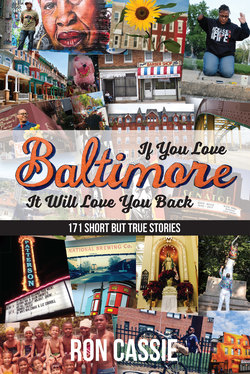Читать книгу If You Love Baltimore, It Will Love You Back - Ron Cassie - Страница 10
На сайте Литреса книга снята с продажи.
ОглавлениеLauraville
Hampnett Avenue
June 12, 2008
1. The Polaroid Guy
Jim Lucio opens a shoe box, searches, and then pulls out a photo he took nearly two decades ago. It’s a Polaroid of a teenage girl wearing an orange bikini, floating atop a blue swimming pool, her white legs and arms splaying casually as she looks up at the camera.
At a glimpse, it’s simply a youthful summer snapshot. Hold the picture a second longer and it becomes evident it’s also a terrific portrait, an expressive subject framed at a quirky angle, compellingly composed, saturated with color. Time has not faded the image—the sunlight still glimmers in the water around the girl—or the memory.
“That’s my cousin Lisa from 1990 at a country club in Carmel Valley we used to sneak into to go swimming on hot days,” Lucio says, 39, with a smile in his Lauraville home studio. “I do like the fact you can tell it’s mine, that same qualities in my pictures today are there early on.”
Last spring, Lucio, a former City Paper graphic designer and the co-owner of Flux Studios gallery, assembled a bunch of his Baltimore portraits in a self-published coffee-table collection called MONDO DEFEKTO: The Polaroid Photography of Jim Lucio. (Defekto is a moniker he uses on Flickr, the popular photo-sharing website.)
“Basically, [the self-published book] has been a marketing tool to get a ‘real’ book deal,” he explains. “I made a hundred, numbered them and sold them for $50.” And he actually sold a few, too. “It did help add to my non-existent income” he laughs, “and paid a couple months of the mortgage.”
Getting a “real” book deal is becoming more urgent for one simple reason: The film that’s made pictures magically appear for 60 years is about to disappear itself.
Lucio was initially drawn to Polaroid film as a teenager because he was impatient—he didn’t want to wait a week for his film to develop (this, of course, was before the dawn of digital cameras). Later, he became attached to the rich quality of the color and the unique intimacy between subject and artist that Polaroids encourage.
Embraced over the years by artists such as Andy Warhol, Robert Rauschenberg, Robert Maplethorpe, David Hockney and Chuck Close, Polaroid stopped manufacturing cameras two years ago. When they announced in February it was shuttering film production as well, websites such as SavePolaroid.com popped up, organizing online petitions and letter-writing campaigns, trying to convince another company to buy the rights to the patented chemical emulsion process.
Twenty years after he started taking his instant portraits, Lucio’s recognized as “the Polaroid guy” around Baltimore for his cool, yet intimate close-ups of pals, hipsters, curious strangers, Jesus freaks, tattooed super heroes, punks, addicts (including a friend who since died of an overdose), naked wrestlers, masked misfits, musicians, magicians, Roller Girls, bartenders, bike messengers, trapeze artists, and transvestites.
“Jim relates to everybody, he spends time with them and they open up to him,” says photographer Josh Sisk, a friend who has been published in Rolling Stone, among other magazines. “Even those people who are more theatrical seem to reveal themselves underneath whatever they are wearing. When you see his photographs, you might think, ‘This person looks a little crazy’, but you also think that this is someone I’d enjoy talking to. I just know I can’t do what he does.”
When he first heard that Polaroid was discontinuing film production, Lucio bought all the spare film he could find, got on a waiting list at a New York camera store, and began stockpiling film in his refrigerator in Lauraville. “I might have to get another one for food eventually,” he says, noting the instant film comes with an expiration date and lasts longer in cold storage.
Eventually, Lucio will have to forge on without his trusty 1980s-era Spectra camera. He promises the loss of Polaroid film won’t deter him forever. He has other interests, including writing and painting, and he adds, “I take digital photos like everyone else.”
“But yeah, I’m upset over it,” he sighs. “I’ve taken probably 2,000 portraits in Baltimore over the past six years.” He estimates he has maybe 700 exposures left and says he’s trying to let go gracefully. To that end, he started chronicling his final several hundred shots in a photo blog, “The Last Days of Polaroid.”
“I love the nostalgia aspect of Polaroid and his style, but really his stuff is about the community of Baltimore,” says Gspot co-founder Jill Sell. Her gallery/performance space hosted Lucio’s “In Your Face” show—where he took one portrait every single day for a year—back in 2006. “Baltimore is a small village and his work makes you feel connected to that, to the neighborhood people you might know in his photographs, and also to the strangers because you can check them out, too.”
This month, Lucio’s exhibiting new work at his Flux Gallery at Station North alongside digital portrait artist Chase Lisbon. And in November, Metro Gallery owner Sarah Williams has scheduled him for a solo exhibition. “One thing that’s funny, is that now when people see Jim with his camera, they’ll purposely try to get in front of him to see if he’ll take their picture,” Williams says.
Lucio’s philosophy can be boiled down to this: Everyone deserves a portrait.
“I think there is something interesting and of value in everyone,” Lucio says. “I don’t think that I have actually ever put this into words before, but maybe what I’ve wanted all along is for everyone else to realize that, too.”
(Postscript: As of March 2020, the Safe Streets initiative, Barksdale included, remains active in McElderry Park and has expanded to other neighborhoods including, Cherry Hill, Park Heights, Sandtown-Winchester, Penn-North, Brooklyn, and Franklin Square.)
